AMD Ryzen 9 5980HS Cezanne Review: Ryzen 5000 Mobile Tested
by Dr. Ian Cutress on January 26, 2021 9:00 AM EST- Posted in
- CPUs
- AMD
- Vega
- Ryzen
- Zen 3
- Renoir
- Notebook
- Ryzen 9 5980HS
- Ryzen 5000 Mobile
- Cezanne
Ryzen 5000 Mobile: SoC Upgrades
While the introduction page focuses mainly on the change to Zen 3 cores, AMD has explained to AnandTech that there are plenty of other changes in this update which enable both performance and efficiency, as well as battery life enhancements, for users.
From this point on I will start using the silicon codenames, such as
- Cezanne (Ryzen 5000 Mobile with Zen 3),
- Lucienne (Ryzen 5000 Mobile with Zen 2),
- Renoir (Ryzen 4000 Mobile, all Zen 2),
- Vermeer (Ryzen 5000 Desktop, all Zen 3),
- Matisse (Ryzen 3000 Desktop, all Zen 2)
Double Cache and Unified Cache for Cezanne
To reiterate the primary SoC change for Cezanne compared to Renoir, the eight cores now have a unified cache rather than two cache segments. On top of this, the cache size has also doubled.
This is similar to what we saw on the desktop, when AMD introduced Vermeer – Vermeer with Zen 3 had a unified cache over Matisse with Zen 2. At that time, AMD was pointing to the unified cache enabling better gaming performance as it lowered the ‘effective’ latency for CPU memory requests in that combined cache region. The same thing is expected to hold true for the new Cezanne silicon in Ryzen 5000 Mobile, and will play a key part in enabling that +19% IPC increase from generation to generation.
Improved Memory Controller for Cezanne and Lucienne
One of the key metrics in mobile processors is the ability to eliminate excess power overhead, especially when transitioning from an active state to an idle state. All major silicon vendors that build laptop processors work towards enabling super-low power states for when users are idle, because it increases battery life.
A lot of users will be used to features that keep the processor cores in low power states, or the graphics, but also part of this is the interconnect fabric and the memory controller. One of the new developments for Ryzen 5000, and in both Cezanne on Zen 3 and Lucienne on Zen 2, is that AMD has enabled deeper low-power states for the memory physical layer (PHY) interface. This enables the system to save power when the memory subsystem is either not needed or in a period of low activity. This means putting the fabric and memory on its own voltage plane, but also enabling the required logic to drive it to a lower power when idle. AMD states that the low-dropout regulators (LDOs) are configured to enable this transition, and in certain circumstances, allow the PHY to be bypassed to further lower power consumption.
The tradeoff with having a part of the processor in such a low power state is the time it takes to recover from idle, which is also a metric to keep track of. AMD is stating that the design in Ryzen 5000 also enables a fast exit to full activity, meaning that the high performance modes can be entered quickly.
Also on the memory front, it would appear that AMD is doubling capacity support for both LPDDR4X and DDR4. For this generation, Cezanne systems can be enabled with up to 32 GB of LPDDR4X-4267 (68.2 GB/s), or up to 64 GB of DDR4-3200 (51.2 GB/s). The benefits of LPDDR4X are lower power and higher bandwidth, while DDR4 enables higher capacity and a potentially upgradable design.
Per-Core Voltage Control for Cezanne and Lucienne
In line with the same theme of saving power, not only should the periphery of the core be managed for idle use, but the cores should as well. In Ryzen 4000 Mobile, AMD had a system whereby each core could have a separate frequency, which saved some power, but the drawback was that all the cores were on a single voltage plane and so even if a core was idle when another one was heavily loaded, all cores were running at that top voltage. This changes with all members of the Ryzen 5000 Mobile family, as both Cezanne and Lucienne will both feature voltage control on a per-core level.
The slide from AMD shows it best – the cores running at higher frequencies get higher voltage, and the cores that are idling can reduce their voltage to save power. One of the main limits to enabling this sort of profile, aside from actually having the control to do it in the first place, is to do it fast enough for it both to count towards power consumption but also such that it is transparent to the user – the cores should still be able to come to a high voltage/high frequency state within a suitable time. AMD’s design works with operating system triggers and quality of service hooks to apply high-frequency modes in a task-based format.
On AMD’s desktop processors, we saw that the introduction of a feature called CPPC2 helped enable this, and the same is true on the mobile processors, however it took another generation to do the required design and firmware changes.
Power and Response Optimization (CPPC2) for Cezanne and Lucienne
As we accelerate into the future of computing, making the most out of each individual bit of silicon is going to matter more. This means more control, more optimization, and more specialization. For Cezanne and Lucienne, AMD is implementing several CPPC2 features first exhibited on desktop silicon to try and get the most out of the silicon design.
‘Preferred Core’ is a term used mostly on the desktop space to indicate which CPU core in the design can turbo to the highest frequency at the best power, and through a series of operating system hooks, the system will selectively run all single-threaded workloads on that core assuming no other workload is present. Previously, threads could bounce around to enable a more equal thermal distribution – AMD will now selectively keep the workload on the single core until thermal limits kick in, enabling peak performance and no extra delays from thread switching. For overclockable systems, this typically also represents the best core for boosting the frequency, which becomes relevant for Ryzen 5000 Mobile and the new HX series processors.
Another part of CPPC2 is frequency selection, which reduces the time for the transition from low-frequency to high-frequency from 30 milliseconds down to under 2 milliseconds. This equates to a 2-frame adjustment in frequency being reduced down to sub-frame adjustments. The consequences of this enables workloads that occur for shorter than 30 milliseconds can take advantage of a momentarily higher frequency and get completed quicker – it also enables the system to be more responsive to the user, not only in idle-to-immediate environments, but also in situations where power is being distributed across the SoC and those ratios are adjusting for the best performance, such as when the user is gaming. Also enabling load-to-idle transitions on the order of 2 milliseconds improves battery life by putting the processor in a lower power state both quicker and more often, such as between key presses on the keyboard.
The third part of CPPC2 is the migration away from discrete legacy power states within the operating system. With an OS that has a suitable driver (modern Windows 10 and Linux), frequency control of the processor is returned back from the OS to the processor, allowing for finer grained transitions of when performance or power saving is needed. This means that rather than deal with the several power states we used to, the processor has the full continuous spectrum of frequencies and voltages to enable, and will analyze the workflow to decide how that power is distributed (the operating system can give hints to the processor to aid in those algorithms).
GPU Improvements on Cezanne and Lucienne: Vega 8 to Vega 8+
As mentioned on the previous page, one of the criticisms leveled at this new generation of processors is that we again get Vega 8 integrated graphics, rather than something RDNA based. The main reason for this is AMD’s re-use of design in order to enable a faster time-to-market with Zen 3. The previous generation Renoir design with Zen 2 and Vega 8 was built in conjunction with Cezanne to the point that the first samples of Cezanne were back from the fab only two months after Renoir was launched.
If we look at the change in integrated graphics from the start of Ryzen Mobile. The first generation Raven Ridge was built on 14nm, had Vega11 graphics, and had a maximum frequency around 1200 MHz. The graphics in that Renoir design were built on 7nm, and despite the jump down from Vega11 to Vega8, efficiency was greatly increased and frequency had a heathy already a jump up to 1750 MHz. Another generation on to Cezanne and Lucienne, and the graphics gets another efficiency boost, enabling +350 MHz for added performance.
Part of this update is down to tweaks and minor process updates. AMD is able to control the voltage regulation better to allow for new minimums, reducing power, and has enabled a new frequency sensitive prediction model for performance. With the greater power controls on the CPU and SoC side, this means that power budget can be more readily accessible by the integrated graphics, allowing for higher peak power consumption, which also helps boost frequency.
Note that these features apply to both Cezanne and Lucienne, meaning that the Zen 2 products in the Ryzen 5000 Mobile do get a sizeable boost in graphics performance over Renoir here. Ultimately it is that 15 W market for which this update is aimed, given that the H-series (including HS and HX) are likely to be paired with discrete graphics cards.
As and when AMD decides to move from Vega to RDNA, we’re likely going to see some of the Cezanne be re-used such that we might see Zen3 + RDNA in the future, or the combined Zen 4 + GPU chip might be a full upgrade across the board. This is all speculation, but AMD’s CEO Lisa Su has stated that being able to re-use silicon designs like this is a key part of the company’s mobile processor philosophy going forward.
Security Updates in Cezanne
One of the features of Zen 3 is that it enables AMD’s latest generation of security updates. The big update in Zen 3 was the additional of Control Flow Enforcement Technology, known as CET. This is where the processor will create shadow stacks for return calls to ensure that the correct return addresses are called at the end of functions; similarly indirect branch jumps and calls are monitored and protected against should an attacker attempt to modify where an indirect branch is headed.
Both AMD and Intel have spoken about including Microsoft Pluton security in their processors, and we can confirm that neither Cezanne nor Lucienne have Pluton as part of the design. Both AMD and Intel have stated that it will be integrated ‘in the future’, which seems to suggest we may still be another generation or two away.
Process Node Updates on Cezanne and Lucienne
Perhaps one of the smaller updates this time around, but AMD has stated that both Cezanne and Lucienne use the latest intra-process node updates on N7 for these products. While both previous generation Renoir and these two use TSMC’s N7 process, over the lifecycle of the manufacturing node minor changes are made, sometimes to reduce defect density/increase yield, while others might be voltage/frequency updates enabling better efficiency or a skew towards better binning at a different frequency. Usually these additions are minor to the point of not being that noticeable, and AMD hasn’t said much beyond ‘latest enhancements’.


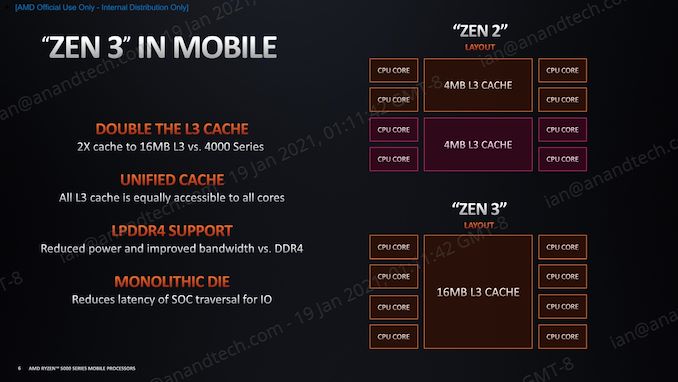
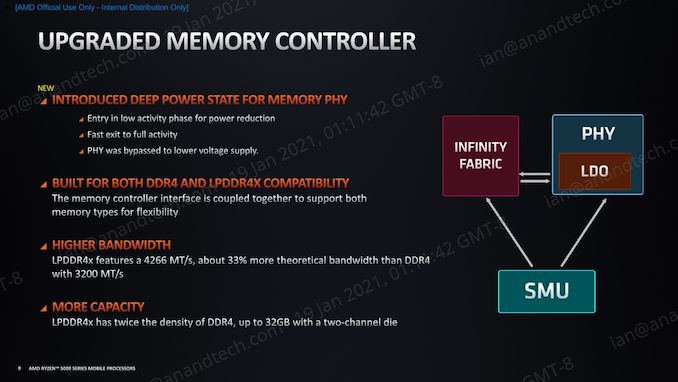

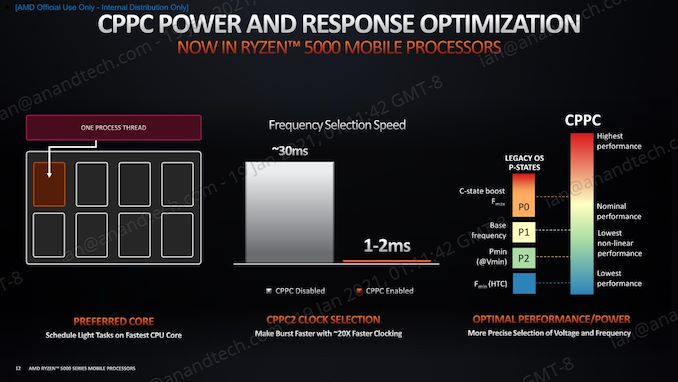
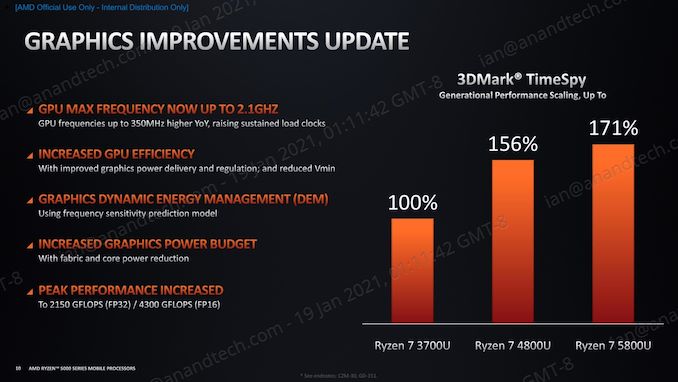
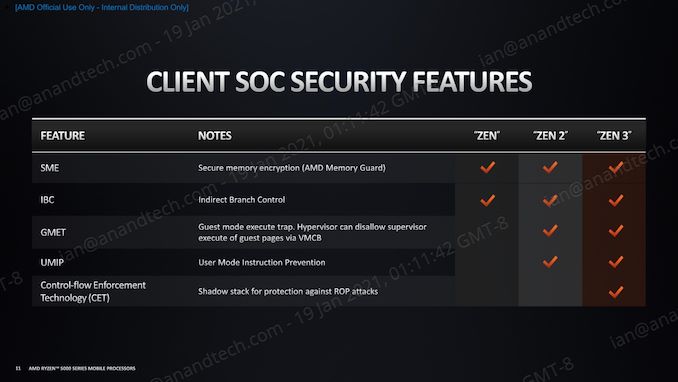








218 Comments
View All Comments
ToTTenTranz - Tuesday, January 26, 2021 - link
Is there any mention to the number and speed of PCIe lanes on Cezanne?I've been seeing reports of it only having x8 PCIe 3.0 lanes, which could present a problem to AMD's apparent goal of pairing Cezanne with discrete GPUs.
Also, I've read the explanation for the super weird resolutions chosen for the IGP tests, but it still comes off as rather irrelevant.
The author first claims the IGP is good for eSports, but then there are no eSports games being tested.
eSports is also apparently the reason the author is trying to pull >60FPS out of these SoCs, but I don't see a single title that anyone would want to play at those framerates.
The memory bandwidth limitation is also presented as a fact to be aware of, but then the author chooses very low render resolutions that are less likely to be impacted by memory bandwidth.
The Vega 8 at 2100MHz has a fillrate between the Xbox One and the PS4, a compute performance well above the PS4 and with LPDDR4X it has a memory bandwidth similar to that of the XBox One (without eDRAM).
IMO it would be a much more interesting procedure to test 8th-gen multiplatform games at resolutions and settings similar to the 8th-gen consoles, than trying to push Borderlands 3 to run at 90FPS at a 360p resolution that no one is ever going to enable.
The only useful result I see in there is FFXV at 720p medium.
Makaveli - Tuesday, January 26, 2021 - link
Why is apple silicon the "true challenge"I've already invested into the X86 eco system and all my software is there, why would I even consider an M1 regardless or performance?
And the same could be said for someone invested in the apple eco why would they even look at an x86 product?
pSupaNova - Tuesday, January 26, 2021 - link
Because a laptop that can run for hours/days with light use, is performant, does not need a fan is going to fly of the shelves.Watch Apple's market share explode as x86 users switch.
Ptosio - Tuesday, January 26, 2021 - link
I'm quite sure there'd be plenty Zen 3 designs that can run fanless for 10h+ with performance enough for 90% of users on the web/streaming/office etc. And that's before gets access to TSMC 5nm.For typical user invested in Windows/x86 software, there's still no compelling reason to switch to Apple silicon. Plus, at the price MacBooks go, you can get features unheard of in the Apple world, such as 4k OLED, touchscreen with stylus, 360 design, upgradable memory (affordable 32GB RAM and 4TB storage for less than Apple would charge for 8/1), discrete GPU with vast games' catalogue...
Not to take away from M1 superiority, but x86 is still simply good enough and would only get better.
Meteor2 - Thursday, February 4, 2021 - link
A typical user invested in x86 isn't going to change to Apple, no, but they're not the typical user. THE typical user is a lot more software-agnostic, and yes, ARM Apple is going to take marketshare. It's inevitable.Speedfriend - Wednesday, January 27, 2021 - link
Apple market share explode? That is hilarious. The average cost of a laptop sold last year was $400. Remind me what the cheapest Mac costs? Most purchasers have no idea about relative performance which is why they are still buying laptop with 8th generation Intel inside. Even battery life has little impact when x86 laptop claim to have up to 15 hours.Where Mac will take some share back is in professional designers where they had lost share over the past 5 years. But even then, the lack of multi monitor support may hamper that.
Deicidium369 - Wednesday, January 27, 2021 - link
Apple Market will expand slightly - but not from people moving from PC to Mac. People using a Mac by choice will continue to buy and use AppleThe hoops you need to jump thru for a 2nd monitor is kinda ridiculous - move designed to sell TB docking stations
Deicidium369 - Wednesday, January 27, 2021 - link
I get 12 or 13 hours from my Tiger Lake XPS13 - which is about 10 hours longer than I need...DigitalFreak - Tuesday, January 26, 2021 - link
IIRC, all their current mobile CPUs that support external graphics have 8 PCIe 3.0 lanes. That's more than enough for any dedicated GPU in a laptop right now.ToTTenTranz - Tuesday, January 26, 2021 - link
All current external GPUs have an immense bottleneck due to Thunderbolt 3.0 only using 4 PCIe 3.0 lanes.I don't know if Asus' 8x solution is enough, either.